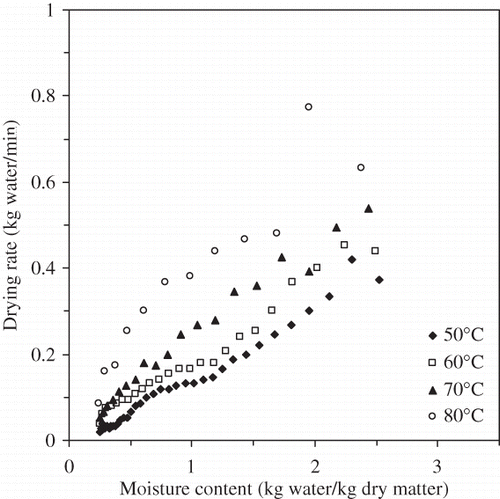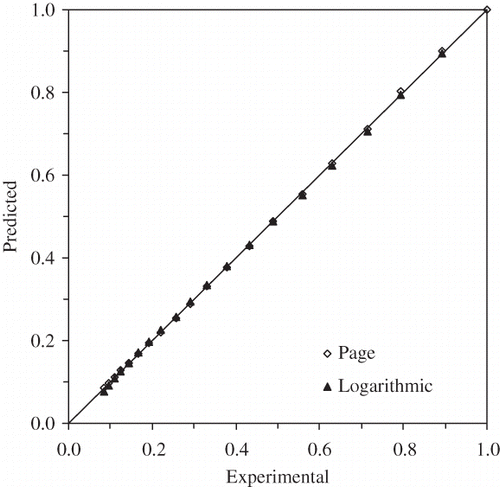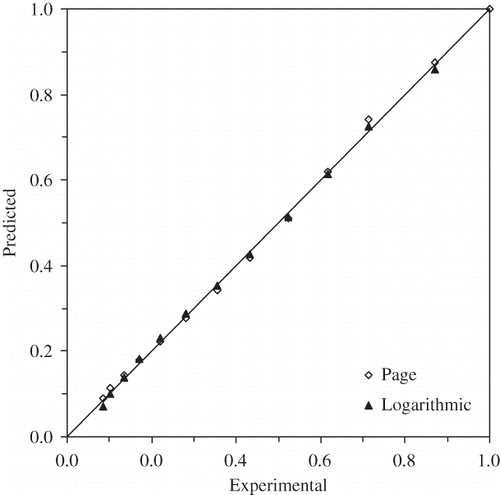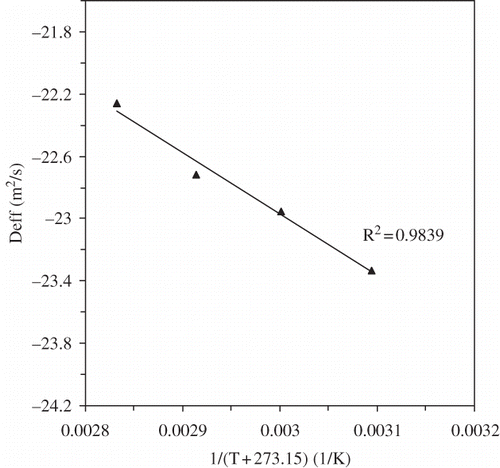Abstract
Drying characteristics of bananas were experimentally determined. The drying experiments were carried out in a hot air dryer at four inlet temperatures of 50, 60, 70 and 80°C, at a constant air velocity of 2.4 m/s and relative humidity of 4–25%. The experimental results were fitted to five thin-layer drying models and it was found that the Page and Logarithmic models gave better fit that the other models. Values of the effective diffusivity ranged from 7.374 × 10−11 to 2.148 × 10−10 m2/s. Activation energy for moisture diffusion of the banana slices was found to be 32.65 kJ/mol.
INTRODUCTION
Bananas are among the oldest and the most valued crop plants of the tropics and subtropics all over the world. India is the largest producer of the banana in the world. Other major producers include the Philippines, China, Ecuador, Indonesia, Tanzania, Mexico, Thailand, and Costa Rica. Banana production in Turkey was 201,115 metric tons in 2008.Citation[1] Banana have a high nutrition value and is a good source of energy due to its high level of starch and sugar, as well as been a source of vitamins A and C, potassium, calcium, sodium and magnesium. It is perishable and cannot be stored for long periods nor can be stored frozen. Therefore, bananas can be dried in order to save the part of the production that will not be readily consumed, since drying is a classical method of food preservation, which provides an extension of shelf-life, lighter weight for transportation and less space for storageCitation.[2 ,Citation3] Besides the preservation, drying adds value to banana. Banana chip is one such value-added product with a crispy and unique taste consumed as a snack food and an ingredient in breakfast cereals.Citation[4]
Drying can be described as an industrial preservation method in which water content and activity of fruits and vegetables are decreased by heated air to minimize biochemical, chemical and microbiological deterioration. The major objective in drying food products is the reduction of the moisture content to a level, which allows safe storage over an extended period, minimise packaging requirements and reduce shipping weights.Citation[5,Citation6]Currently, sun drying is still the most widely used method. However, it has some problems related to the contamination with dust, soil, sand particles and insects, and being weather dependent. Also, the required drying time in this drying technique can be quite long.Citation[7] Therefore, using solar and hot-air dryers, which are far more rapid, providing uniformity and hygiene, are inevitable for agricultural drying processes.Citation[8,Citation9]
Recently, there have been much research on the drying characteristics of various vegetables and fruits, such as strawberry,Citation[8] peach slices,Citation[9] apricot,Citation[10] kiwi fruit,Citation[11] tropical fruits, namely kiwi, avocado and banana,Citation[12] fig,Citation[13] green mango,Citation[14] tomato,Citation[15,Citation16] golden apple,Citation[17] and red apple.Citation[18] However, studies on banana drying in literature are scarce. Drying of bananas was done by hot air, but temperatures and air velocities differed greatly depending on the laboratory. Nguyen and PriceCitation[19] investigated the effect of air temperatures ranging from 30 to 70°C and at air velocity of 1 m/s on drying kinetics of banana slabs. Demirel and Turhan Citation[4] dried banana slices at temperatures ranging from 40 to 70°C and at air velocity between 3.1 and 3.6 m/s. They investigated the effect of pretreatment solutions on drying behavior of banana slices. Baini and LangrishCitation[20] dried banana slices in a tunnel dryer at 60 and 80°C. They reported that the Fickian diffusion model had a good fit the experimental data. Dandamrongrak et al.Citation[6] dried banana samples at 50°C with an air velocity of 3.1 m/s. They reported that the two-term exponential model was found to be the best model for describing the drying curves. The aim of this work was (1) to observe the effect of air drying temperature on the drying rate and time; (2) to fit the experimental data to five thin layer drying models; and (3) to determine the effective diffusivity and activation energy, for drying of banana.
MATERIAL AND METHODS
Raw Material
Ripe bananas of Cavendish variety were purchased from a local supermarket in Istanbul, Turkey, and used immediately after purchase for each experiment. The initial moisture content of banana slices was determined using a standard method,Citation[21] by vacuum drying at 70°C for 24 h over a magnesium sulfate desiccant. This was repeated three times to obtain a reasonable average. The initial moisture content of the samples was 73.2 ± 0.5% (w.b.).
Experimental Procedure
Drying experiments were carried out using a hot air dryer (APV & PASILAC Limited of Carlisle, England) that is described previously by DoymazCitation[10] and installed in the Chemical Engineering Department of Yildiz Technical University, Istanbul, Turkey. The hot air dryer was equipped with an electrical heater, adjustable centrifugal fan, drying basket and proportional temperature controller. The air velocity in dryer was measured with Testo 440 vane probe anemometer (Lutron, AM-4201, Taiwan) with a precision of ±0.1 m/s.
The drying experiments were carried out at four inlet temperatures of 50, 60, 70, and 80°C, relative humidity and equilibrium moisture content between 4–25%, and 0.012–0.020 kg water/kg dry matter, respectively (). The relative humidity and equilibrium moisture content values were determined using wet and dry bulb temperatures of drying air obtained from the psychometric chart. The air temperature in the dryer was regulated to ±1°C using a temperature controller. The air velocity above the product was 2.4 m/s, and air was forced by a centrifugal fan. The flow of the air was horizontal to the product.
Table 1 Drying conditions during experiment in the hot air dryer
Before the drying process, bananas were washed, peeled, weighed and cut into 0.5 ± 0.1 cm thick with cutting machine. One hundred grams of ripe bananas were used in each experiment. The dryer was started about 1 h before drying experiments to achieve steady-state conditions. After, the samples were placed on the perforated tray in a thin single layer. The weight loss of the samples was recorded using a Mettler digital balance (Model BB3000) with a range of 0–3000 g and an accuracy of 0.1 g at 15 minutes intervals. Drying of banana was finalized when the moisture content decreased to 20 ± 0.5% (w.b.)Citation[19] from an initial value of 73.2 ± 0.5% (w.b.). By the end of the drying process, the samples were removed, cooled in room temperature for 10 min and sealed in polyethylene bags for storage. The experiments were replicated three times and the average of the moisture ratio at each value was used for drawing the drying curves.
Mathematical Modeling
Moisture ratio data of banana slices were fitted five thin-layer drying models listed in . The moisture ratio (MR) and drying rate (DR) of banana slices during drying experiments were calculated using the following equations:
Table 2 Thin-layer drying models tested for banana slices
where MR, M 0, M e, Mt , and Mt+dt are the moisture ratio, initial moisture content, equilibrium moisture content, moisture content at t and moisture content at t + dt (kg water/kg dry matter), respectively, t is time (min).
Statistical Analysis
The regression analysis was performed by the Levenberg-Marquardt procedure in Statistica 6.0 computer program. The coefficient of determination (R2) was primary criterion for selecting the best model to describe the drying curves. In addition to R2, root mean square errors (RMSE) was used to determine the goodness of the fit. For quality fit, R2 value should be higher and RMSE value should be lower.[Citation8,Citation17,Citation26,Citation28,Citation29] RMSE can be calculated as:
where MR exp,i is the experimental moisture ratio at observation i; MRpre,i is the predicted moisture ratio at this observation; N is number of observations; and z is number of constants.
RESULTS AND DISCUSSION
Drying Curves
The effect of air temperature on drying kinetics is shown in . As expected, the temperature has a significant effect on drying process. There is acceleration in the drying process due to an increase in the drying temperature from 50 to 80°C. High temperature decreases the relative humidity of the drying air and therefore drying potential increases. In general, the time required to reduce the moisture ratio to any given level was dependent on the drying condition, being the highest at 50°C and lowest 80°C. With drying, the times taken to reduce moisture content of banana slices from the initial 73.2 ± 0.5% (w.b.) to a final 20 ± 0.5% (w.b.) were 525, 360, 285, and 180 min, respectively. As a result, the effect of air temperature has been reflected in drying time. Similar results were obtained for the experimental conditions examined and are in accordance with results obtained for agricultural products.Citation[11,Citation15,Citation26,Citation30]
Figure 1 Variation of moisture content of banana slices versus drying time for various temperatures.
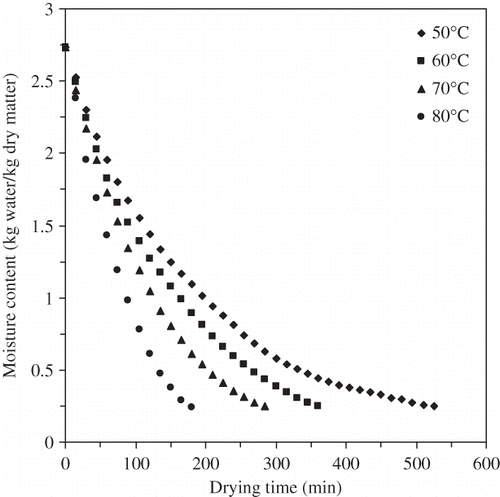
The drying rates versus drying time have been represented in . It is apparent that drying rate decreases continuously with moisture content. In this figure, there was no constant rate period observed and drying occurred in the falling-rate period. The curves typically demonstrated smooth diffusion-controlled drying behavior under all run conditions. Moreover, an important influence of air drying temperature on drying rate could be observed in these curves. Drying rate increased with the increase of air-drying temperature and the highest values of drying rate were obtained during the experiment at 80°C of the drying air. The results are generally in agreement with the observations of earlier researchers of some food products.Citation[8,Citation16,Citation28,Citation31]
Selection and Evaluation of the Model
Five thin-layer drying models were used to fit the moisture ratio as a function of drying time (). presents the results of non-linear regression analysis of fitting the proposed models to experimental data and comparison criteria used to evaluate goodness of fit namely, R2 and RMSE. The Page and Logarithmic models provided an excellent fit to the experimental data with a value of R2 of greater than 0.9991, indicating a good fit. The values of RMSE obtained from the two models were less than 0.03630, which in the acceptable range. Plots of experimental and predicted of moisture ratio values by Page and Logarithmic models are shown in . The predicted data generally banded around the straight line which showed the suitability of the Page and Logarithmic models in describing drying characteristics of banana slices. The results were generally in agreement with some literature studies on drying of various agricultural products, such as Simal et al.Citation[11] for kiwi fruit, Ceylan et al.Citation[12] for banana slices, Xanthopoulos et al.Citation[13] for fig, and SacilikCitation[15] for tomato drying.
Table 3 Statistical results obtained from various thin-layer drying models
Figure 3 Comparison of experimental moisture ratio of banana slices with fitted moisture ratio from the Page and Logarithmic models at 50°C.
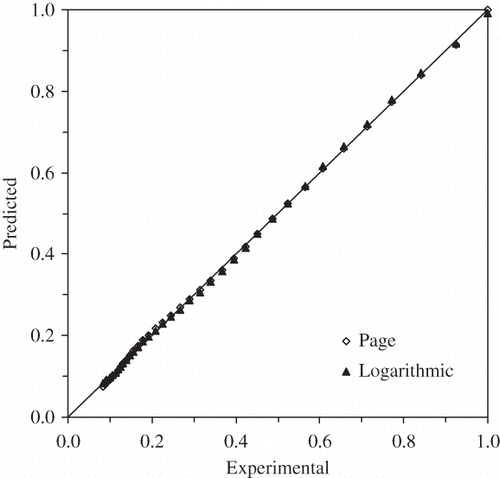
Figure 4 Comparison of experimental moisture ratio of banana slices with fitted moisture ratio from the Page and Logarithmic models at 60°C.

Effective Diffusivity and Activation Energy
The experimental drying data for the determination of diffusivity coefficients were interpreted by using Fick's second diffusion model:
The solution of Fick's law (EquationEq. [4]), with the assumptions of moisture migration being by diffusion, negligible shrinkage, constant diffusion coefficients and temperature and for infinite slabCitation[32]:
where, Deff is the effective diffusivity coefficient (m2/s); L is the half-thickness of the slab (m); and n is the positive integer.
For long drying times, EquationEq. [5] simplifies to a limiting form of the diffusion equation as followsCitation[33]:
The effective diffusivity can be calculated from the slope of the left-hand side of EquationEq. (6) versus drying time. It is expected that a plot of ln (MR) versus drying time give a straight line with a slope (k0) of:
Values of Deff for different temperatures are presented in . Effective diffusivity values ranged from 7.374 × 10−11 to 2.148 × 10−10 m2/s. It can be seen that the values of Deff increased greatly with increasing temperature. The values reported herein are within the general range of 10−9 to 10−11 m2/s for agricultural products.Citation[34] Similar variations were also observed during drying of mango slices,Citation[14] banana,Citation[6,Citation20] kiwi fruit,Citation[11] and red apple.Citation[18] These values are consistent with the present estimated Deff values for banana slices.
Table 4 Values of effective diffusivity obtained for banana slices at different temperatures
The activation energy that expresses the dependence of the diffusion as a function of the temperature was calculated by the Arrhenius equationCitation[35]:
where D0 is the constant in Arrhenius equation (m2/s); Ea is the activation energy (kJ/mol); T is temperature of air (°C); and R is the universal gas constant (kJ/mol K). EquationEq. (8) can be rearranged as:
The logarithm of effective diffusivity (D eff) as a function of the reciprocal of absolute temperature (T) is plotted in . The plot was found to be essentially a straight line in the range of temperatures investigated, indicating Arrhenius dependence. From the slope of the straight line described by the Arrhenius equation, the value of activation energy were found to be 32.65 kJ/mol. Comparison of activation energy value with those of various agricultural products () showed that the value obtained in this study were in good accordance. Moreover, the activation energy value for banana slices was within the general range of 15 to 40 kJ/mol for various food materials.Citation[37]
Table 5 Some agricultural products activation energies
CONCLUSIONS
The effect of temperature on thin-layer drying of banana slices in a hot air dryer was investigated. Increasing air temperature significantly reduced the drying time of the banana slices. The entire drying process occurred in falling rate period. The values of effective diffusivity for drying at 50–80°C of air temperature and 2.4 m/s of air velocity ranged from 7.374 × 10−11 to 2.148 × 10−10 m2/s, with the increase in drying temperature. Temperature dependence of the diffusivity coefficients was described by Arrhenius-type relationship. The values of activation energy were found to be 32.65 kJ/mol for banana slices. Five thin-layer drying models have been analyzed for their suitability in defining the drying of banana slices. Goodness of fit of the experimental data by the proposed models was determined by comparing determination of coefficient and root mean square errors. The Page and Logarithmic models were found to satisfactorily describe the thin-layer drying kinetics of banana slices.
| NOMENCLATURE | ||
| a,b,c, n | = |
Experimental constants |
| Deff | = |
Effective diffusivity, m2/s |
| D0 | = |
Constant in Arrhenius equation, m2/s |
| Ea | = |
Activation energy, kJ/mol |
| k | = |
Drying rate constant, 1/min |
| k0 | = |
Slope |
| L | = |
Slice half-thickness, m |
| MR | = |
Moisture ratio (dimensionless) |
| Me | = |
Equilibrium moisture content, kg water/kg dry matter |
| M0 | = |
Initial moisture content, kg water/kg dry matter |
| Mt | = |
Moisture content at t, kg water/kg dry matter |
| Mt+dt | = |
Moisture content at t+dt, kg water/kg dry matter |
| N | = |
Number of observations |
| R | = |
Gas consant, kJ/mol.K |
| R2 | = |
Coefficient of determination |
| T | = |
Drying temperature, °C |
| t | = |
Drying time, min |
REFERENCES
- FAO Statistical Database, 2007. Available http://www.fao.org (Accessed: 16 December 2009 ).
- Oliveira , I.M. , Fernandes , F.A.N. , Rodrigues , S. , Sousa , P.H.M. , Maia , G.A. and Figueiredo , R.W. 2006 . Modeling and Optimization of Osmotic Dehydration of Banana Followed by Air Drying . Journal of Food Process Engineering , 29 : 400 – 413 .
- Fernandes , F.A.N. , Rodrigues , S. , Gasparetoand , O.C.P. and Oliveira , E.L. 2006 . Optimization of Osmotic Dehydration of Bananas Followed by Air-drying . Journal of Food Engineering , 77 : 188 – 193 .
- Demirel , D. and Turhan , M. 2003 . Air-drying Behavior of Dwarf Cavendish and Gros Michel Banana Slices . Journal of Food Engineering , 59 : 1 – 11 .
- Okos , M.R. , Narsimhan , G. , Singh , R.K. and Weitnauer , A.C. 1992 . “ Food Dehydration ” . In Handbook of Food Engineering , Edited by: Heldman , D.R. and Lund , D.B. 437 – 562 . New York : Marcel Dekker .
- Dandamrongrak , R. , Young , G. and Mason , R. 2002 . Evaluation of Various Pre-treatments for the Dehydration of Banana and Selection of Suitable Drying Models . Journal of Food Engineering , 55 : 139 – 146 .
- Tarhan , S. , Ergunes , G. and Taser , O.F. 2006 . Selection of Chemical and Thermal Pretreatment Combination to Reduce the Dehydration Time of Sour Cherry (Prunus cerasus L.) . Journal of Food Process Engineering , 29 : 651 – 663 .
- Akpinar , E.K. and Bicer , Y. 2006 . Mathematical Modeling and Experimental Study on Thin Layer Drying of Strawberry . International Journal of Food Engineering , 2 ( 1 ) Article 5
- Kingsly , R.P. , Goyal , R.K. , Manikantan , M.R. and Ilyas , S.M. 2007 . Effects of Pretreatments and Drying Air Temperature on Drying Behaviour of Peach Slice . International Journal of Food Science and Technology , 42 : 65 – 69 .
- Doymaz , I. 2004 . Effect of Pre-treatments Using Potassium Metabisulphide and Alkaline Ethyl Oleate on the Dying Kinetics of Apricots . Biosystems Engineering , 89 : 281 – 287 .
- Simal , S. , Femenia , A. , Garau , M.C. and Roselló , C. 2005 . Use of Exponential, Page's and Diffusional Models to Simulate the Drying Kinetics of Kiwi Fruit . Journal of Food Engineering , 66 : 323 – 328 .
- Ceylan , I. , Aktas , M. and Dogan , H. 2007 . Mathematical Modeling of Drying Characteristics of Tropical Fruits . Applied Thermal Engineering , 27 : 1931 – 1936 .
- Xanthopoulos , G. , Oikonomou , N. and Lambrinos , G. 2007 . Applicability of A Single-layer Drying Model to Predict the Drying Rate of Whole Figs . Journal of Food Engineering , 81 : 553 – 559 .
- Corzo , O. , Bracho , N. and Alvarez , C. 2008 . Water Effective Diffusion Coefficient of Mango Slices at Different Maturity Stages during Air Drying . Journal of Food Engineering , 87 : 479 – 484 .
- Sacilik , K. 2007 . The Thin-layer Modeling of Tomato Drying Process . Agriculturae Conspectus Scientificus , 72 : 343 – 349 .
- Brooks , M.S. , Abou El-Hana , N.H. and Ghaly , A.E. 2008 . Effects of Tomato Geometries and Air Temperature on the Drying Behaviour of Plum Tomato . American Journal of Applied Sciences , 5 : 1369 – 1375 .
- Menges , H.O. and Ertekin , C. 2006 . Mathematical Modeling of Thin Layer Drying of Golden Apples . Journal of Food Engineering , 77 : 119 – 125 .
- Kaya , A. , Aydin , O. and Demirtas , C. 2007 . Drying Kinetics of Red Delicious Apple . Biosystems Engineering , 96 : 517 – 524 .
- Nguyen , M.H. and Price , W.E. 2007 . Air-drying of Banana: Influence of Experimental Parameters, Slab Thickness, Banana Maturity and Harvesting Season . Journal of Food Engineering , 79 : 200 – 207 .
- Baini , R. and Langrish , T.A.G. 2007 . Choosing and Appropriate Drying Model for Intermittent and Continuous Drying of Bananas . Journal of Food Engineering , 79 : 330 – 343 .
- Association of Official Analytical Chemists (AOAC) . 1990 . Official Methods of Analysis , 910 – 928 . Arlington, VA : AOAC .
- Kabganian , R. , Carrier , D.J. and Sokhansanj , S. 2002 . Physical Characteristics and Drying Rate of Enchinacea Root . Drying Technology , 20 : 637 – 649 .
- Ghodake , H.M. , Goswami , T.K. and Chakraverty , A. 2006 . Mathematical Modeling of Withering Characteristics of Tea Leaves . Drying Technology , 24 : 159 – 164 .
- Rafiee , S. , Keyhani , A. and Jafari , A. 2008 . Modeling Effective Moisture Diffusivity of Wheat (Tajan) during Air Drying . International Journal of Food Properties , 11 : 223 – 232 .
- Sharma , G.P. and Prasad , S. 2004 . Effective Moisture Diffusivity of Garlic Cloves Undergoing Microwave-convective Drying . Journal of Food Engineering , 65 : 609 – 617 .
- Vega-Gálvez , A. , Lemus-Mondaca , R. , Bilbao-Sáinz , C. , Yagnam , F. and Rojas , A. 2008 . Mass Transfer Kinetics during, Convective Drying of Red Pepper var. Hungarian (Capsicum annuum L.): Mathematical Modeling Evaluation of Kinetic Parameters . Journal of Food Process Engineering , 31 : 120 – 137 .
- Ethmane Kane , C.S. , Jamali , A. , Kouhila , M. , Mimet , A. and Ahachad , M. 2008 . Single-layer Drying Behavior Mexican Tea Leaves (Chenopodium ambrosioides) in A Convective Solar Dryer and Mathematical Modeling . Chemical Engineering Communications , 195 : 787 – 802 .
- Khazaei , J. 2007 . Daneshmandi, S. Modelling of Thin-layer Drying Kinetics of Sesame Seeds: Mathematical and Neural Networks Modelling . International Agrophysics , 21 : 335 – 348 .
- Roberts , J.S. , Kidd , D.R. and Padilla-Zakour , O. 2008 . Drying Kinetics of Grape Seeds . Journal of Food Engineering , 89 : 460 – 465 . 2008
- Akal , D. , Kahveci , K. and Cihan , A. 2007 . Mathematical Modeling of Drying of Rough Rice in Stacks . Food Science and Technology International , 13 : 437 – 445 .
- Singh , S. , Raina , C.S. , Bawa , A.S. and Saxena , D.C. 2006 . Effect of Pretratments on Drying and Rehydration Kinetics and Color of Sweet Potato Slices . Drying Technology , 24 : 1487 – 1494 .
- Crank , J. 1975 . The Mathematics of Diffusion , 2nd , 42 – 61 . New York : Oxford University Press .
- Kajtna , J. , Šebenik , U. , Krajnc , M. and Golob , J. 2008 . IR Drying of Water-based Acrylic PSA Adhesives . Drying Technology , 26 : 323 – 333 .
- Madamba , P.S. , Driscoll , R.H. and Buckle , K.A. 1996 . The Thin-layer Drying Characteristics of Garlic Slices . Journal of Food Engineering , 29 : 75 – 97 .
- Barbosa , F.F. , Melo , E.C. , Santos , R.H.S. , da Rocha , R.P. , Martinazzo , A.P. , Radünz , L.L. and Gracia , M.N. 2007 . Evaluation of Mathematical Models for Prediction of Thin-layer Drying of Brazillian Lemano-scented Verbena Leaves lippia alba (Mill) N.E. Brown . Revista Brasileira de Produtos Agroindustriais , 9 : 71 – 80 .
- Lee , G. and Hsieh , F. 2008 . Thin-layer Drying Kinetics of Strawberry Fruit Leather . Transactions of the ASABE , 51 : 1699 – 1705 .
- Rizvi , S.S.H. 1986 . “ Thermodynamic Properties on Foods in Dehydration ” . In Engineering Properties of Foods , Edited by: Rao , M.A. and Rizvi , S.S.H. New York : Marcel Dekker .
